Part V: Race Stereotyping
& Censorship in Classic Animation
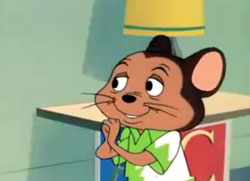 A Warner Brothers Technicolor Merrie Melodies cartoon, The Mouse that Jack Built (1959), has an authentic all-star vocal cast. Jack is voiced by Jack Benny, Mary by Mary Livinston, Don by Don Wilson, "The Maxwell" by Mel Banc, & Rochester by Eddie "Rochester" Anderson. Mel Blanc plays Jack's old auto, the Maxwell.
A Warner Brothers Technicolor Merrie Melodies cartoon, The Mouse that Jack Built (1959), has an authentic all-star vocal cast. Jack is voiced by Jack Benny, Mary by Mary Livinston, Don by Don Wilson, "The Maxwell" by Mel Banc, & Rochester by Eddie "Rochester" Anderson. Mel Blanc plays Jack's old auto, the Maxwell.
It's a perfectly reasonable spoof of the Jack Benny Show on radio & early television, & from the cartoon's own context you'd think Jack & Rochester were roommates, not a stingy rich man with a black servant.
Even so, accusations of racism induced Warner Brothers some years later to distribute a version with shortened appearance of Rochester to a bare minimum, & have Eddie Anderson's rough voice replaced by a colorless voice.
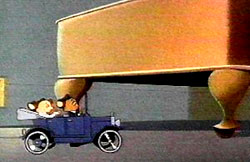 This injury to Anderson's vocal work & his famous character's presence is vastly the more offending act. This injury to Anderson's vocal work & his famous character's presence is vastly the more offending act.
And the weirdest thing is that the mouse Rochester is practically white, maybe a half-shade darker than mouse Jack. Fear of racism avoided by avoiding black characters! That's just another form of racism.
In the wall of a Beverly Hills mansion, a mouse named Jack is playing his violin, badly. He then wants to get dressed for an evening out with Mary, & cries out, "Oh Rochester, where's my white jacket?"
To which Rochester answers off camera, "I'm wearing it!" He'd rented it from Jack for a week for $5, but stingy Jack points out, "The week was over five minutes ago, so bring it here."
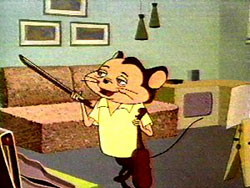 Before Mary arrives, Jack wants to check out his cheese vault, & takes a scary journey into hlis treasure cellar. He passes over numerous deadly traps to reach his cheese vault, & comunicate with Ed, the guard locked in the vault since World War I. Before Mary arrives, Jack wants to check out his cheese vault, & takes a scary journey into hlis treasure cellar. He passes over numerous deadly traps to reach his cheese vault, & comunicate with Ed, the guard locked in the vault since World War I.
The cute mouse Mary arrives. The fat mouse Don also shows up briefly. When Mary wants to go to an expensive club, Jack balks, & they go to a cheap niteclub instead. Rochester drives them to the Kit Kat Klub. It turns out to be a real cat who has desguised himself as a niteclub, the cat's tongue rolled out as a "red carpet."
They soon realize they've entered the gullet of a real cat, & suddenly the real Jack Benny awakens from his dream, with one silly little fillip for close.
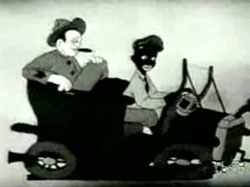 A wartime Porky Pig cartoon Meet John Doughboy (1941) was designed to build moral of soldiers & civilians in deadly times. The title plays off Frank Capra's then-current hit Meet John Doe (1941).
A wartime Porky Pig cartoon Meet John Doughboy (1941) was designed to build moral of soldiers & civilians in deadly times. The title plays off Frank Capra's then-current hit Meet John Doe (1941).
One wonders how many black soldiers had their moral deflated rather than restored when their role in the war effort is depicted exclusively as working as chaufeur to Jack Benny, & with Rochester only a blackface minstrel-show figure.
Porky in his draftee's army outfit is the emcee to a full house who has come to see a collection of clips, newsreels, or trailers "chock full of military secrets" as Porky promises. A series of fragmentary gags follows.
First up is a newsreel "America's Defense Effort." We see a surprisingly creepy "defense industry" plant belching huge amounts of polution into a dismal sky, then an animated parody of actual war-effort films, loaded with puns. "Then came the draft." with lots of gags about getting drafted. Then a section of war equipment in use on the "Testing Ground."
More war gags take is to the end, with the overall message being superior military strength for America. It ends with the Statue of Liberty spraying insecticide on enemy planes. This cartoon is as illuminating of the times as it is creepy.
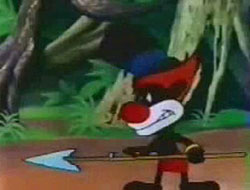 Which is Witch (1948), a Warner Brothers Looney Tune in Technicolor, takes us to Darkest Africa, where a sorcerer (named I. C. Dots) is mixing up a potion in his cauldron.
Which is Witch (1948), a Warner Brothers Looney Tune in Technicolor, takes us to Darkest Africa, where a sorcerer (named I. C. Dots) is mixing up a potion in his cauldron.
He is missing one important ingredient. A rabbit. After dancing about his cauldron with shield & spear & mixing in ingredients, he is left with only the missing ingredient to finish his project.
As luck would have it, Bugs Bunny is vacationing in the area. A story unfolds which is pretty much the same old Elmer Fudd story but with a little squire of an African witchdoctor proving his ineptitude at outwitting a rabbit.
The story is too familiar & there's very little about the witchdoctor beyond his racist blackface design to set him apart from Fudd. Bugs arrives at the African village & assumes the boiling cauldron is a hot bath prepared just for him, until the sorcerer puts a tight lid on the thing.
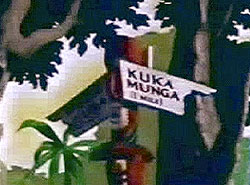 The offensive little nut's luck doesn't last long, & the chase is soon on anew. Bugs flees to a steamboat on the river. The offensive little nut's luck doesn't last long, & the chase is soon on anew. Bugs flees to a steamboat on the river.
In attempted pursuit, the little black dude gets eaten by a crocodile, & Bugs has to save him from teh belly of the croc. The end.
This one's pretty lousy, no matter how you cut it, though it may be going a bit far for pressure groups to force Warner Brothers to withdraw it from circulation due to its insensitivities. It was first withdrawn from circulation in 1968, reasonable enough in a decade of protest & civil rights. And when it was shown on the Cartoon Network in 2001, a campaign was undertaken to sink it again, as if hiding offending art rather than admitting to its content is the decent thing. It's head-in-sand, & the censorship is more offensive than such cartoons.
There are two altered versions that attempted through partial censorship to make it more acceptible. In the 1990s Nickelodion aired it without the scene of of Bugs inserting plates in his mouth to pose as a native. A CBS version didn't mind the plates, but censored the scene of bugs in the witchdoctor's cookpot.
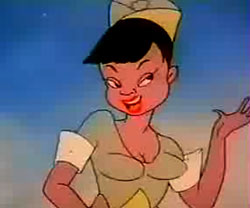 Scrub Me Mama with a Boogie Beat (1941) from Walter Lantz for Universal was built around a song by Don Raye, a delightful boogie woogie number which had been a #10 hit for the Andrew Sisters just one year before.
Scrub Me Mama with a Boogie Beat (1941) from Walter Lantz for Universal was built around a song by Don Raye, a delightful boogie woogie number which had been a #10 hit for the Andrew Sisters just one year before.
The cartoon is populated by stereotyped African America figures that have offended many, as it is indeed offensive. But it's also somehow a truly great piece of animation.
It's kind of schizophrenic with "vertically divided ego" since it means well & wants to celebrate black musicianship, but the white folks who wrote it, drew it, everythinged it, just couldn't imagine anything other than the worst possible race stereotypes for the celebration.
The tale is set in Lazytown, populated by lazy darkies. Black folks have lips almost as big as the rest of their head, very ugly caricatures of lazy people in the rural village. Even the fish in the river are lazy. Two guys get in a fight, in slow motion.
It's weird to note Walter Lantz never did mature in his outlook about racial stereotyping. He went to his grave claiming there was nothing offensive about any of his cartoons with black characters (he made eight such; all were withdrawn from circulation during the Civil Rights era, which made Lantz peevish).
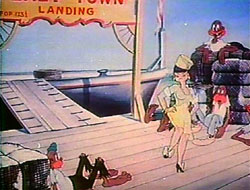 There are some good arguments that could be launched in these cartoon's favor -- as art, as history, as a method of comprehending the depth of racist ignorance among whites in the past -- but Lantz's arguments that they're not offensive just isn't the argument to try. There are some good arguments that could be launched in these cartoon's favor -- as art, as history, as a method of comprehending the depth of racist ignorance among whites in the past -- but Lantz's arguments that they're not offensive just isn't the argument to try.
But then a jitterbug gal gets off a riverboat for a one-hour layover in Lazytown. Finally there's a black charactrer who isn't ugly.
I doubt anyone thought about it when designing this beauty, but among the traits they selected was the fact that she's a "yaller gal," only a half-shade short of passing for white, derived from the standard racist assumption that white people are prettier than black people. And to make sure this lie is believable, every truly dark character in this cartoon is designed to be ugly.
The more intional point of the tale, though, is that an enervated population lazying through the summer can be energized by boogie woogie.
"In Harlem there's a little place where everyone goes/ To see the way a washer woman washes her clothes/ If you like boogie woogie rhythm, she's got a beat/ Let the boogie woogie washer woman give you a treat.../ Rubbly-up-dub, that's just the way she rubs/ Rubbly-up-dub, that's just the way she scrubs..."
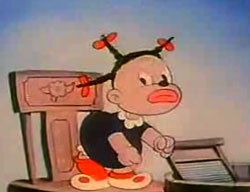 All the children (drawn as pickaninnies) & lazy men come to life, some grabbing their own musical instruments to join in. All the children (drawn as pickaninnies) & lazy men come to life, some grabbing their own musical instruments to join in.
Children & babies are the ugliest creatures imaginative, as the natural beauty of black children was outside the imagining of these white animators. So the only black folk who aren't ugly in this thing is the girl from Harlem & some similar village yaller gals who dance & do some harmonies.
Throw in watermelon gags along the way, & this cartoon hits all the buttons. How fantastically bizarre that Walter Lantz never figured out what he did wrong, always insisting "we never offended or degraded the colored race."
There are some cartoons I could almost see feeling that way about, but in retrospect, even if never beforehand, if Lantz wasn't a complete moron, he should've been sorry for the more reprehensible aspects of this occasionally thrililng but relentlessly racist film. It shouldn't've been banned, but it can't be defended either.
For conclusion our city gal reboards the steamboat & waves farewell with her handkerchief, as the village keeps boogying.
Start over from Part 1:
Animated Stereotypes of Africans & African Americans
copyright © by Paghat the Ratgirl
|
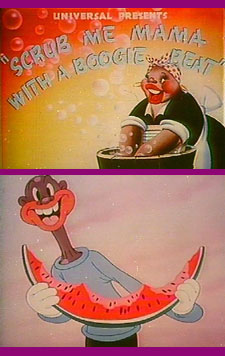
 A Warner Brothers Technicolor Merrie Melodies cartoon, The Mouse that Jack Built (1959), has an authentic all-star vocal cast. Jack is voiced by Jack Benny, Mary by Mary Livinston, Don by Don Wilson, "The Maxwell" by Mel Banc, & Rochester by Eddie "Rochester" Anderson. Mel Blanc plays Jack's old auto, the Maxwell.
A Warner Brothers Technicolor Merrie Melodies cartoon, The Mouse that Jack Built (1959), has an authentic all-star vocal cast. Jack is voiced by Jack Benny, Mary by Mary Livinston, Don by Don Wilson, "The Maxwell" by Mel Banc, & Rochester by Eddie "Rochester" Anderson. Mel Blanc plays Jack's old auto, the Maxwell. This injury to Anderson's vocal work & his famous character's presence is vastly the more offending act.
This injury to Anderson's vocal work & his famous character's presence is vastly the more offending act. Before Mary arrives, Jack wants to check out his cheese vault, & takes a scary journey into hlis treasure cellar. He passes over numerous deadly traps to reach his cheese vault, & comunicate with Ed, the guard locked in the vault since World War I.
Before Mary arrives, Jack wants to check out his cheese vault, & takes a scary journey into hlis treasure cellar. He passes over numerous deadly traps to reach his cheese vault, & comunicate with Ed, the guard locked in the vault since World War I.
 Which is Witch (1948), a Warner Brothers Looney Tune in Technicolor, takes us to Darkest Africa, where a sorcerer (named I. C. Dots) is mixing up a potion in his cauldron.
Which is Witch (1948), a Warner Brothers Looney Tune in Technicolor, takes us to Darkest Africa, where a sorcerer (named I. C. Dots) is mixing up a potion in his cauldron. The offensive little nut's luck doesn't last long, & the chase is soon on anew. Bugs flees to a steamboat on the river.
The offensive little nut's luck doesn't last long, & the chase is soon on anew. Bugs flees to a steamboat on the river. Scrub Me Mama with a Boogie Beat (1941) from Walter Lantz for Universal was built around a song by Don Raye, a delightful boogie woogie number which had been a #10 hit for the Andrew Sisters just one year before.
Scrub Me Mama with a Boogie Beat (1941) from Walter Lantz for Universal was built around a song by Don Raye, a delightful boogie woogie number which had been a #10 hit for the Andrew Sisters just one year before. There are some good arguments that could be launched in these cartoon's favor -- as art, as history, as a method of comprehending the depth of racist ignorance among whites in the past -- but Lantz's arguments that they're not offensive just isn't the argument to try.
There are some good arguments that could be launched in these cartoon's favor -- as art, as history, as a method of comprehending the depth of racist ignorance among whites in the past -- but Lantz's arguments that they're not offensive just isn't the argument to try. All the children (drawn as pickaninnies) & lazy men come to life, some grabbing their own musical instruments to join in.
All the children (drawn as pickaninnies) & lazy men come to life, some grabbing their own musical instruments to join in.